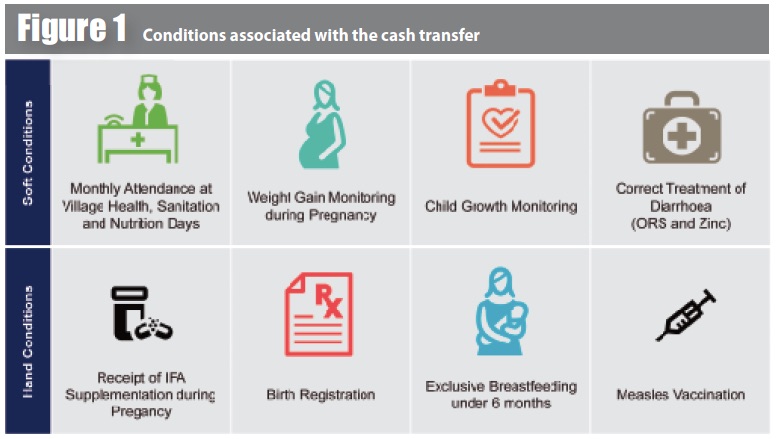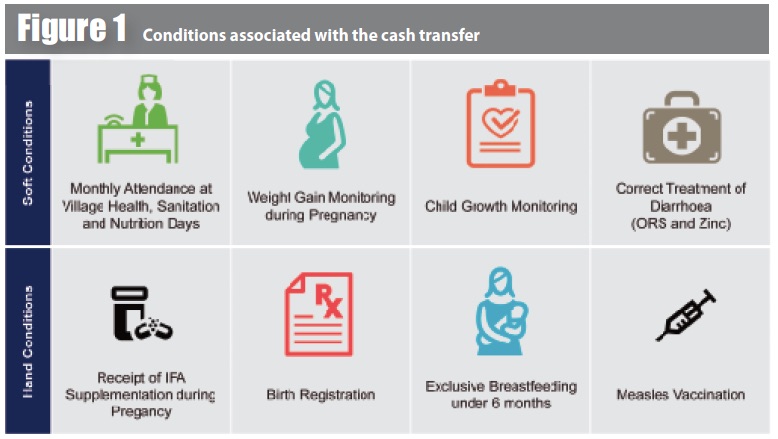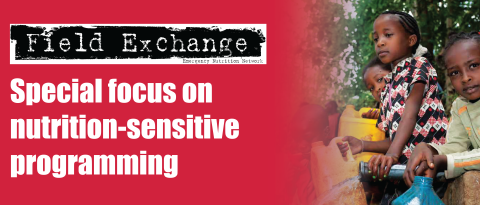Cash transfers and child nutrition
Summary of research1
Location: Global
What we know: Cash transfer (CT) programming is an expanding form of social protection that has potential to improve child nutrition.
What this article adds: A recent UNICEF report examined the available evidence of the impact of CTs on the underlying and immediate determinants of nutritional status considering food security, health and care pathways. There is positive evidence from sub-Saharan Africa and Latin America regarding impact on household food security resources, on healthcare access, and on aspects of hygiene and sanitation. Impact on care practices and empowerment is under-studied. Evidence of impact on dietary intake, health status and nutritional status is limited, with little data, mixed results and little exploration of pathways. In conclusion, evidence of impact on immediate determinants is particularly limited. Research gaps include CT impacts on children’s dietary diversity, caregiver behaviours, intra-household violence, and stress.
 Childhood malnutrition remains a significant global problem with an estimated 162 million children under five suffering from stunted growth. CT programmes are an important method of providing social protection and have the potential to contribute to the improvement of child nutrition. Both the number and size of CT programmes have increased considerably in the last two decades and conservative estimates now suggest that around one billion people currently have access to CT programmes in the developing world (Barrientos, 2013). This paper aims to provide a comprehensive overview of the impacts of CT programmes on the immediate and underlying determinants of child nutrition, including the most recent evidence from impact evaluations in sub-Saharan Africa.
Childhood malnutrition remains a significant global problem with an estimated 162 million children under five suffering from stunted growth. CT programmes are an important method of providing social protection and have the potential to contribute to the improvement of child nutrition. Both the number and size of CT programmes have increased considerably in the last two decades and conservative estimates now suggest that around one billion people currently have access to CT programmes in the developing world (Barrientos, 2013). This paper aims to provide a comprehensive overview of the impacts of CT programmes on the immediate and underlying determinants of child nutrition, including the most recent evidence from impact evaluations in sub-Saharan Africa.
The paper adopts the UNICEF extended model of care conceptual framework of child nutrition. In this framework, by making additional financial resources available in the household, there are three main pathways through which CTs may impact the underlying determinants of child nutrition for food security, health, and care. In Figure 1 the colour green represents the pathways through which a CT programme may affect nutritional outcomes for children, while pink represents a potential mediating effect and blue represents a potential moderating effect. For example, the child’s dietary intake is mediated by the caregiver’s feeding practices and feeding styles; household food security is moderated by the availability and price level of food and by external shocks.
The paper argues that through extra resources for food security, health and care, CT programmes have the potential to positively impact the child’s health status and the child’s nutritional intake to determine the nutritional status of the child. The paper then tests this by examining available evidence of the impact of CTs on the underlying and immediate determinants of nutritional status and direct effects on nutritional status (as measured by anthropometry).
There is strong evidence that CT programmes have a positive effect on resources for food security. In all of the African countries and programmes reviewed, household consumption increased and the majority of the additional income from the transfer was spent on food, with most households improving their diet diversity through the purchase of more nutritious and diverse food. Evidence from Latin America demonstrates similar results (see below).
Evidence also points to positive impacts in terms of resources for health, particularly in terms of preventive healthcare visits and antenatal care-seeking. For example, in Kenya households spent more on healthcare after two years of exposure to the Hunger and Safety Net Programme (Oxford Policy Management, 2012), and in Malawi beneficiaries of the Mchiniji Social Cash Transfer were more likely to receive care when sick compared to non-beneficiaries (Adato & Bassett, 2009). Studies on programmes in Latin America found positive results for preventive health visits and there is some evidence of a significant effect of CT programmes on the number of prenatal procedures in Mexico (Barber & Gertler, 2008).

There is also evidence of positive effects on better hygiene and on the probability of using improved sanitation or water resources. For example, beneficiary households of the Malawian Mchinji Social Cash Transfer were more likely to take a bath, use soap and brush their teeth on a daily basis (Miller, Tsoka, & Reichert, 2008). Households with a pensioner receiving the old-age pension in South Africa were more likely to have a flush toilet and less likely to report an off-site water source (Case, 2004).
In terms of the impact of CT on resources for care, this is an area that is generally understudied. The broader literature suggests a clear relation between nutritional outcome and caregiver feeding behaviours and practices, but there is very little evidence of this impact in the literature reviewed. There is, however, strong evidence that CT programmes improve the mental health of beneficiaries, including reducing levels of stress, and may decrease domestic violence, although more evidence on the impact of CT programmes on domestic violence is needed as results are mixed. For example, a study in Ecuador found that a national CT programme decreased psychological violence for women with higher than primary school education, but for women with lower education the effect depended on the relative level of education compared to her partner and there was an increase in emotional violence in households where the woman’s education was equal to or more than her partner’s (Hidrobo & Fernald, 2012).
There is qualitative evidence on the impact of CT programmes on women’s empowerment, which creates an important mediator for care; however quantitative evidence generates a more heterogeneous picture (van den Bold, Quisumbing & Gillespie, 2013), possibly linked to the difficulty in measuring the concept of empowerment through a survey.
The review identified evidence of the impacts of CT programmes on the two immediate determinants of child nutritional status, dietary intake and health status. The few studies that directly look at children’s dietary intake (as opposed to household diet diversity or other household measures) found no increase in caloric intake of young children, while one study found an increase in the number of days children consumed more nutritious food. This could point to unequal distribution of marginal increases in food resources in the household, especially when household-level measures of diet diversity improve as a result of a CT programme. In terms of children’s health status, the evidence is mixed. Some studies found a significant reduction in common children’s illnesses, such as diarrhoea and acute respiratory infections, while in other cases no significant effects were found. Similar mixed findings appear for vaccination coverage. The only study that investigated children’s levels of a stress-related biomarker, children’s cortisol levels, found a significant reduction due to the CT programme.
The review also examines the evidence related to the direct impact of CT on child nutrition status, measured as height-for-age (HAZ), weight-for-age (WAZ) or in some cases weight-for-age (WHZ). A positive impact on child nutrition outcomes was found in several countries. For example, the old-age pension in South Africa was associated with increased height-for-age (HAZ) in young girls (Duflo, 2000) and children in general (Case, 2001). In addition, longer exposure to the South African Child Support Grant during the first 36 months of life (66% versus 1%), increased children’s HAZ-scores with 0.25 standard deviations (SD) (Aguëro, Carter & Woolard, 2009). After two years of operation the Zambian Child Grant Programme was associated with an increase of 0.196 WHZ-score among children aged three to five (American Institutes for Research, 2013). In Sri Lanka the effect of Samurdhi on children under five exposed to the programme since birth ranged from 0.4-0.5 SD in terms of HAZ-score, with larger effects for children under three (Himaz, 2008). Results from other countries are mixed. For example, in Malawi there was no significant impact of the Mchinji Social Cash Transfer programme on WAZ-scores, but the evaluation found a significant reduction in the prevalence of underweight after one year (Miller et al, 2008). Studies in other countries have found no significant impact of CTs on child nutritional status. For example, a study on Bono Solidario, a CT programme in Ecuador, found that although the transfer seemed to improve children’s nutritional status, this impact was no different to an ordinary household income effect on height and weight (Leon & Younger, 2007). The evidence of direct impact of CT programmes on children’s nutritional status is therefore mixed. In most cases, the pathways of impact are not analysed and it is therefore unclear why some CT programmes have a significant impact on nutritional outcomes and others appear to have a mixed or zero impact.
Overall, the evidence points to a lack of knowledge on the pathways of impact or non-impact and more research is needed. Additional research is needed from the sub-Saharan Africa region as much of the non-impact results come from Latin America. The impacts on the two immediate determinants of child nutritional status, child dietary intake and health status, are also inconclusive. Child dietary intake is often overlooked as most studies focus on the household-level impacts of CT programmes. For health status, the pathways of impact are again unclear. Some studies have found positive impacts on the reduction of common diseases, while others find no effects. It is unclear which underlying mechanisms cause these mixed results.
The authors conclude that, in terms of underlying determinants, there is strong evidence that CT programmes have an impact on food consumption, food security, household diet diversity, the uptake of preventive health services, and caregiver physical health. CT programmes therefore have a role in increasing resources for food, health and care. However, the evidence to date on the immediate determinants of child nutrition is mixed with respect to whether CTs can positively impact growth-related outcomes among children, particularly in sub-Saharan Africa. Key gaps that should be addressed in future research include CT impacts on more proximate nutrition-related outcomes such as children’s dietary diversity, as well as caregiver behaviours, intra-household violence and stress, all of which have implications for child health and wellbeing.
Footnotes
1 de Groot, R., Palermo, T., Handa, S., Ragno, L.P. and Peterman, A. (2015). Cash Transfers and Child Nutrition: What we know and what we need to know. Innocenti Working Paper No.2015-07, UNICEF Office of Research, Florence.
References
Adato, M. & L. Bassett (2009). Social protection to support vulnerable children and families: the potential of cash transfers to protect education, health and nutrition. AIDS Care: Psychological and Socio-medical Aspects of AIDS/HIV, 21:S1, 60-75.
Agüero, J., M.R. Carter, and I. Woolard, (2009). The Impact of Unconditional Cash Transfers on Nutrition: The South African Child Support Grant. International Poverty Research Center Working Paper.
American Institutes for Research. (2013). Zambia’s Child Grant Program: 24-month impact report. Washington, DC: Author.
Barber, S. L., & Gertler, P. J. (2008). The impact of Mexico’s conditional cash transfer programme, Oportunidades, on birthweight. Tropical Medicine & International Health, 13(11), 1405-1414.
Barrientos, A. (2013). Social assistance in developing countries. Cambridge University Press.
Case, A. (2001). Does Money Protect Health Status? Evidence from South African Pensions. NBER Working Paper 8495: Cambridge, MA. p. 1-32.
Duflo, E. (2000). Grandmothers and Granddaughters: Old-Age Pensions and Intrahousehold Allocation in South Africa. The World Bank Economic Review. 17(1): p. 1-25.
Hidrobo, M., and L. Fernald. (2012). Cash Transfers and Domestic Violence. Journal of Health Economics 32 (1) 304–319.
Himaz, R. (2008). Welfare Grants and Their Impact on Child Health: The Case of Sri Lanka. World Development. 36(10): p. 1843-1857.
León, M. and S. Younger (2007). Transfer Payments, Mothers’ Income and Child Health in Ecuador. Journal of Development Studies. 43(6): p. 1126–1143.
Leroy, J. L., García-Guerra, A., García, R., Dominguez, C., Rivera, J., & Neufeld, L.M. (2008). The Oportunidades program increases the linear growth of children enrolled at young ages in urban Mexico. J Nutr. 2008 Apr;138(4):793-8.
Miller, C. M., Tsoka, M., & Reichert, K. (2008). Impact Evaluation Report External Evaluation of the Mchinji Social Cash Transfer Pilot. Center for International Health and Development Boston University School of Public Health Boston, Massachusetts and The Centre for Social Research University of Malawi.
Oxford Policy Management (2013). Kenya Hunger Safety Net Programme Monitoring and Evaluation Component: Impact Evaluation Final Report: 2009 to 2012. Oxford, United Kingdom.Adato & Bassett, (2009)
Van de Bold, M., A. R. Quisumbing and S. Gillespie (2013). Women’s Empowerment and Nutrition: An Evidence Review. IFPRI Discussion Paper 01294, International Food Policy Research Institute (IFPRI): Washington, DC.


